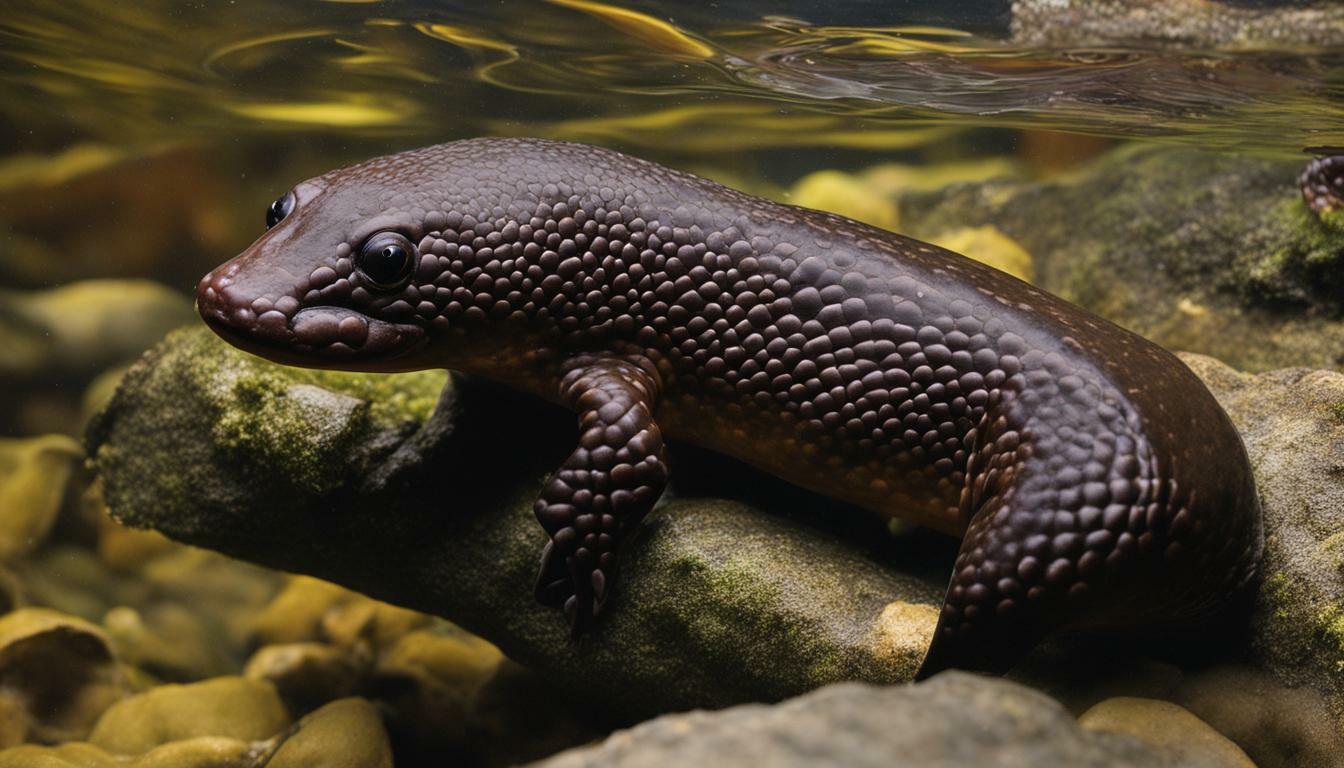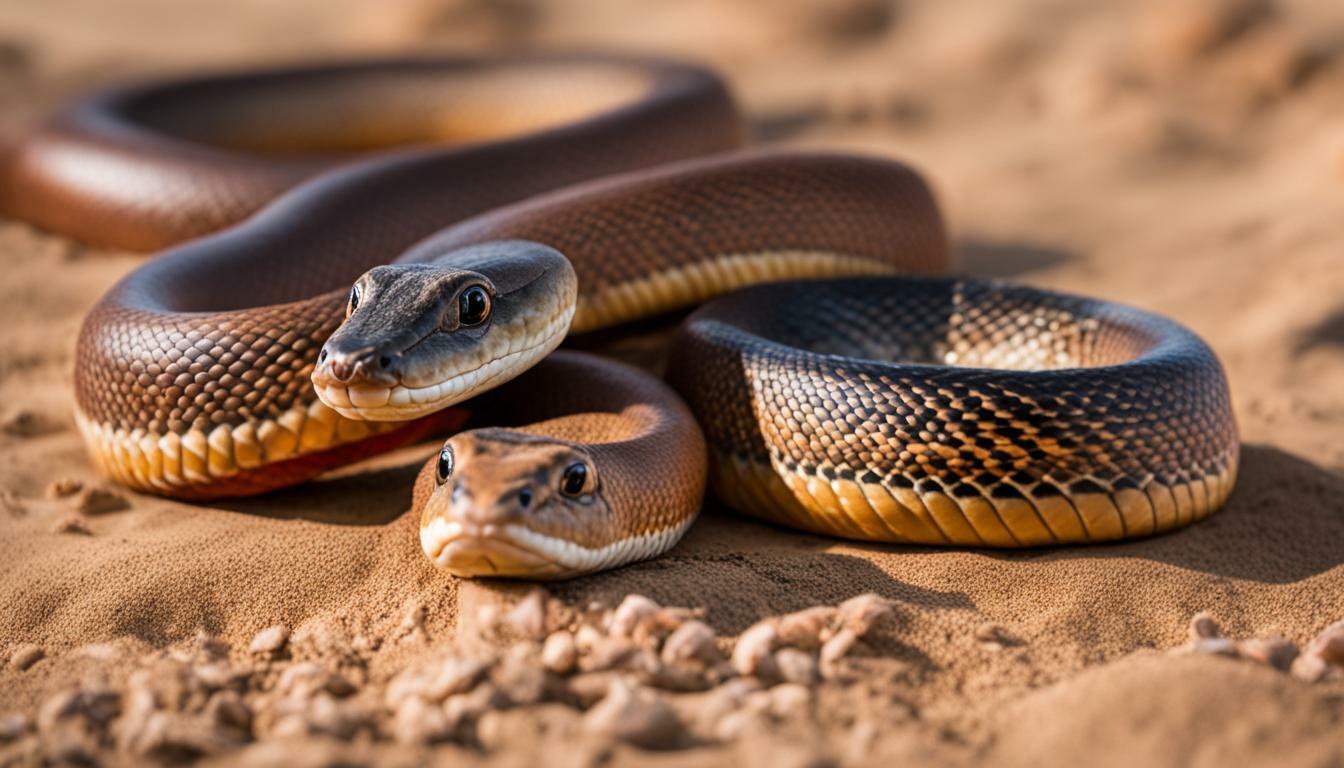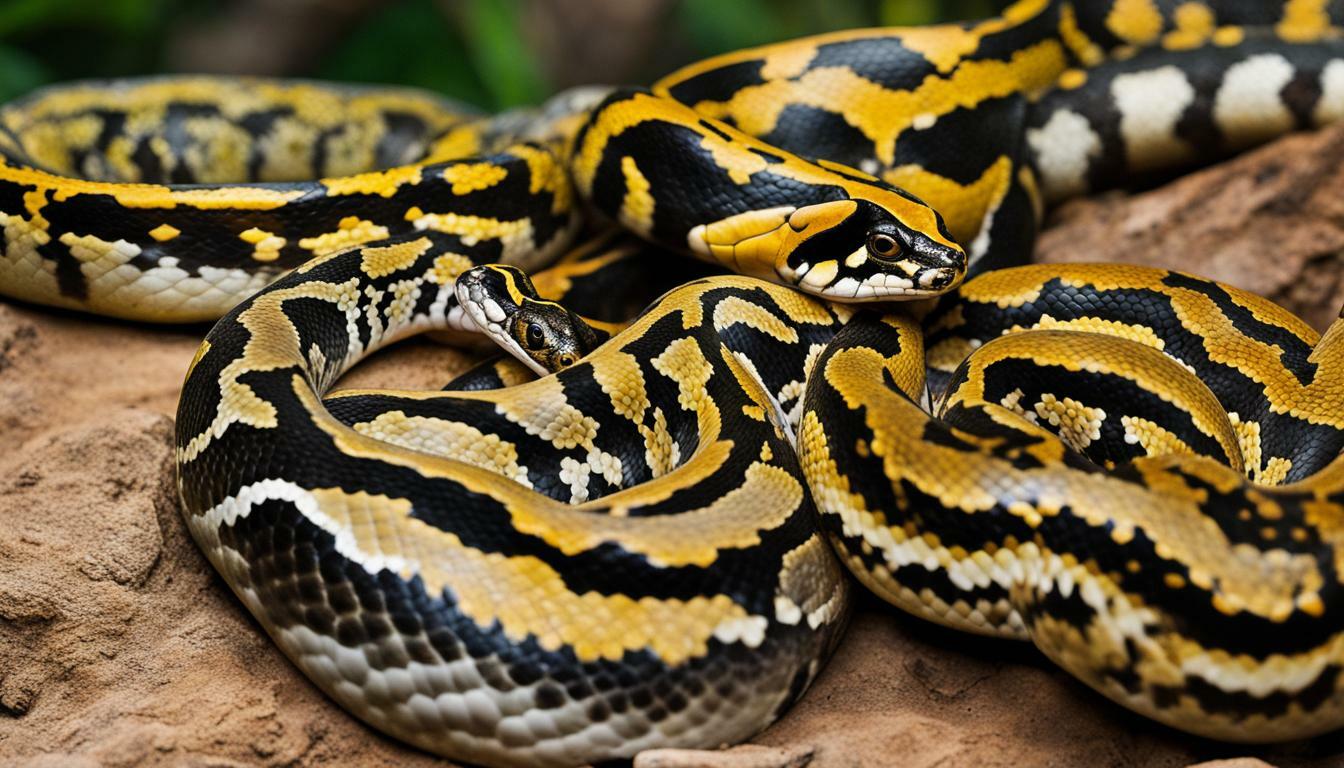Hellbenders and Mudpuppies are two species of salamanders that share similarities but also have distinct characteristics that set them apart. The Eastern Hellbender and Mudpuppy are often misidentified, so it’s important to understand the key differences between these fascinating creatures.
Key Takeaways:
- Mudpuppies are found throughout Ohio, while Hellbenders occur only in the Ohio River Watershed.
- Mudpuppies have bushy, red-colored external gills on the sides of their heads, while Hellbenders do not have external gills.
- Hellbenders have loose and wrinkly skin to aid in gas exchange, while Mudpuppies have smoother skin.
- Hellbenders are larger than Mudpuppies, with a maximum length of up to 24 inches compared to Mudpuppies’ maximum length of 12 inches.
- Both Hellbenders and Mudpuppies are listed as species of concern, emphasizing the importance of correctly identifying them for conservation efforts.
Habitat and Range
Hellbenders are found exclusively in the Ohio River Watershed, while Mudpuppies have a wider range and can be found throughout Ohio. The specific habitat preferences of these two salamander species differ as well.
Mudpuppies are highly adaptable and can be found in various aquatic habitats such as lakes, rivers, streams, and even small ponds. They prefer clear, cool waters with abundant vegetation and rocky substrates.
On the other hand, Hellbenders require larger rivers and streams with fast-flowing, well-oxygenated water. They are typically found under large rocks and boulders, where they create burrows and hide during the day.
Both species are amphibious, meaning they spend their entire lives in or near water. However, Mudpuppies are more tolerant of different habitat types and can be seen in a wider range of freshwater ecosystems.
Table: Habitat and Range Comparison
| Salamander Species | Habitat | Range |
|---|---|---|
| Hellbender | Large rivers and streams with fast-flowing, well-oxygenated water | Ohio River Watershed |
| Mudpuppy | Lakes, rivers, streams, small ponds with clear, cool waters, abundant vegetation, and rocky substrates | Throughout Ohio |
Understanding the specific habitat requirements and ranges of Hellbenders and Mudpuppies is crucial for their conservation. By preserving and restoring suitable habitats, we can ensure the survival of these unique and fascinating salamander species.
Physical Features
Hellbenders have loose and wrinkly skin that aids in gas exchange, while Mudpuppies have smoother skin. This difference in skin texture is related to their distinct habitats and lifestyles. Hellbenders are fully aquatic and live in fast-moving rivers and streams, where their wrinkly skin helps them absorb more oxygen from the water. On the other hand, Mudpuppies are also aquatic but prefer slower-moving bodies of water, such as lakes and ponds, where their smoother skin is sufficient for gas exchange.
Another notable physical feature difference between Hellbenders and Mudpuppies is the presence of external gills in Mudpuppies. These bushy, red-colored gills are located on the sides of their heads and serve as an additional respiratory organ for gas exchange. In contrast, Hellbenders do not have external gills and rely solely on their skin and lungs for respiration.
Both Hellbenders and Mudpuppies have four legs and long bodies, which allow them to navigate through water with ease. However, Hellbenders are generally larger than Mudpuppies, growing up to 24 inches in length compared to Mudpuppies’ maximum length of 12 inches. Their larger size is an adaptation to their habitat and lifestyle, as Hellbenders need to withstand the strong currents of their riverine environments.
| Features | Hellbenders | Mudpuppies |
|---|---|---|
| Skin Texture | Loose and wrinkly | Smooth |
| External Gills | Absent | Present |
| Size | Up to 24 inches | Up to 12 inches |
Understanding the physical features of Hellbenders and Mudpuppies is crucial for accurate identification and conservation efforts. By recognizing these differences, researchers and conservationists can better protect and preserve the habitats of these unique salamander species.
External Gills
One notable difference between Mudpuppies and Hellbenders is the presence of bushy, red-colored external gills on the sides of the Mudpuppy’s head. These external gills serve a vital function in allowing Mudpuppies to breathe underwater, as they are primarily aquatic creatures. The gills act as respiratory organs, extracting oxygen from the water and facilitating respiration. This unique adaptation sets Mudpuppies apart from Hellbenders, which do not possess external gills.
The external gills of Mudpuppies are distinguishable by their vibrant red color, contrasting with the rest of their dark-colored bodies. These gills provide a striking visual feature and are an important part of the Mudpuppy’s biology. They play a crucial role in their ability to survive and thrive in their aquatic habitats.
On the other hand, Hellbenders do not have external gills. Instead, they rely on gas exchange through their skin. Hellbenders have loose and wrinkly skin, which allows for increased surface area, facilitating efficient respiration. Their skin acts as a respiratory organ, absorbing oxygen directly from the surrounding water. This adaptation enables Hellbenders to live in areas with fast-flowing streams and high oxygen levels.
Table 1: Comparison of External Gills Between Mudpuppies and Hellbenders
| Mudpuppies | Hellbenders | |
|---|---|---|
| Presence of External Gills | Yes | No |
| Appearance of External Gills | Bushy, red-colored | N/A |
| Function of External Gills | Respiration, extracting oxygen from water | N/A |
In summary, Mudpuppies have distinctive red external gills, allowing them to breathe underwater, while Hellbenders rely on their loose and wrinkly skin for gas exchange.
Size Comparison
Hellbenders are significantly larger than Mudpuppies, reaching a maximum length of up to 24 inches compared to Mudpuppies’ maximum length of 12 inches. This size difference is quite noticeable when comparing the two species side by side.
Aside from their overall size, Hellbenders also have a bulkier appearance compared to the sleeker Mudpuppies. Their thick bodies and stout heads make them instantly recognizable, while Mudpuppies have a more slender and streamlined body shape.
Despite their size disparity, both Hellbenders and Mudpuppies are adept swimmers. Their long tails help propel them through the water, allowing them to navigate their respective habitats with ease.
Differences in habitat
Hellbenders dwell exclusively in the Ohio River Watershed, while Mudpuppies have a wider range throughout Ohio. This difference in habitat means that Hellbenders require specific conditions and water quality to thrive, making them more susceptible to changes in their environment.
| Features | Hellbenders | Mudpuppies |
|---|---|---|
| Location | Ohio River Watershed | Throughout Ohio |
| External Gills | Absent | Present |
| Skin Texture | Loose and wrinkly | Smooth |
| Size | Up to 24 inches | Up to 12 inches |
Understanding the differences between Hellbenders and Mudpuppies is not only important for enthusiasts and researchers, but also for conservation efforts. Both species are listed as species of concern, highlighting the need to protect their habitats and ensure their survival in the wild.
If you come across a salamander and are unsure about its identification, it is recommended to take a photograph and seek guidance from experts. Correctly identifying these species can contribute to the ongoing conservation initiatives and help monitor their populations effectively. Every individual effort counts towards the protection of these remarkable creatures.
Conservation Status
Both the Eastern Hellbender and Mudpuppy are listed as species of concern, making it crucial to properly identify and protect them. These fascinating aquatic salamanders play important roles in their respective ecosystems, and their decline in numbers is a cause for concern among conservationists.
The Eastern Hellbender, also known as the “snot otter” or “devil dog,” has experienced population declines due to habitat loss, water pollution, and climate change. They rely on clean, fast-flowing streams for survival, but deforestation, agricultural runoff, and urban development have degraded their habitats. The loss of suitable breeding sites and pollution from pesticides and other chemicals have further threatened their populations.
Mudpuppies, on the other hand, face similar threats but are more adaptable to different environments. However, their populations are still declining due to habitat loss, pollution, and incidental capture in fishing nets. Mudpuppies are often caught unintentionally by anglers, and their lack of legal protection in some regions exacerbates their vulnerability.
Conservation Efforts
To conserve Hellbenders and Mudpuppies, various initiatives are underway. These include habitat restoration projects, water quality improvement efforts, and educational campaigns to raise awareness about the importance of these species in freshwater ecosystems.
Scientists and conservation organizations are working together to identify and protect critical habitats for Hellbenders and Mudpuppies. This involves mapping their distribution, monitoring population trends, and implementing conservation strategies that mitigate the threats they face.
| Threats | Conservation Actions |
|---|---|
| Habitat loss | Protecting key breeding and foraging areas, implementing riparian buffer zones, and restoring degraded habitats. |
| Water pollution | Advocating for stricter regulations on industrial and agricultural pollution, as well as promoting sustainable land use practices. |
| Climate change | Monitoring the impact of climate change on their habitats and advocating for policies that mitigate its effects. |
| Incidental capture | Working with anglers and recreational fishermen to promote responsible fishing practices that minimize harm to these species. |
“The Eastern Hellbender and Mudpuppy are unique and valuable components of our freshwater ecosystems. It is our responsibility to ensure their survival for future generations.”
Correctly identifying Hellbenders and Mudpuppies is crucial for conservation efforts. If you come across these salamanders, remember to observe them from a distance and avoid any actions that may disturb their natural behaviors or habitats. If unsure about their identification, consult field guides or seek assistance from local experts or herpetological societies. Photographs can also be submitted to experts for confirmation, ensuring that these remarkable creatures receive the protection they desperately need.
Identifying Hellbenders and Mudpuppies
If unsure about the identification, individuals can send a photograph to experts for assistance in distinguishing between Hellbenders and Mudpuppies. However, there are several key differences that can help in identifying the two species.
Firstly, their location can play a crucial role. Mudpuppies are commonly found throughout Ohio, while Hellbenders occur only in the Ohio River Watershed. So, if you spot one in Ohio, it is more likely to be a Mudpuppy.
Another noticeable difference is the presence of external gills. Mudpuppies have bushy, red-colored external gills on the sides of their heads, which they use to extract oxygen from the water. In contrast, Hellbenders do not have external gills and rely on gas exchange through their skin.
Furthermore, the skin texture can be a distinguishing feature. Hellbenders have loose and wrinkly skin, which helps them with gas exchange. On the other hand, Mudpuppies have smoother skin.
Last but not least, we have the size difference. Hellbenders are much larger compared to Mudpuppies, with a maximum length of up to 24 inches, while Mudpuppies typically reach a maximum length of 12 inches.
If unsure about the identification, individuals can send a photograph to experts for assistance in distinguishing between Hellbenders and Mudpuppies.
| Identification Features | Hellbender | Mudpuppy |
|---|---|---|
| Location | Ohio River Watershed | Throughout Ohio |
| External Gills | Absent | Present, bushy and red-colored |
| Skin Texture | Loose and wrinkly | Smooth |
| Size | Up to 24 inches | Up to 12 inches |
Conclusion
In conclusion, Hellbenders and Mudpuppies may share some similarities, but differences in habitat, physical features, and size make them distinct species of salamanders.
The first key difference lies in their location. Mudpuppies can be found throughout Ohio, while Hellbenders are limited to the Ohio River Watershed. This difference in range is important for understanding their distribution and conservation needs.
Another distinguishing feature is the presence of external gills. Mudpuppies have bushy, red-colored external gills on the sides of their heads, which they use for respiration. In contrast, Hellbenders do not have external gills, relying instead on gas exchange through their loose and wrinkly skin.
Size is also a notable difference between the two species. Hellbenders are larger, reaching a maximum length of up to 24 inches, while Mudpuppies only grow to a maximum length of 12 inches. This size discrepancy is an important factor in their ecological roles and behaviors.
Correctly identifying Hellbenders and Mudpuppies is crucial for conservation efforts, as both species are listed as species of concern. If unsure about the identification, it is recommended to seek expert assistance by providing a photograph for accurate identification.
FAQ
What are the main differences between Hellbenders and Mudpuppies?
Hellbenders and Mudpuppies differ in location, external gills, skin texture, and size.
Where are Hellbenders and Mudpuppies found?
Mudpuppies are found throughout Ohio, while Hellbenders occur only in the Ohio River Watershed.
Do Hellbenders and Mudpuppies have external gills?
Mudpuppies have bushy, red-colored external gills on the sides of their heads, while Hellbenders do not have external gills.
What is the difference in skin texture between Hellbenders and Mudpuppies?
Hellbenders have loose and wrinkly skin to aid in gas exchange through their skin, while Mudpuppies have smoother skin.
How do the sizes of Hellbenders and Mudpuppies compare?
Hellbenders are larger than Mudpuppies, with a maximum length of up to 24 inches compared to Mudpuppies’ maximum length of 12 inches.
Why is it important to correctly identify Hellbenders and Mudpuppies?
Both the Eastern Hellbender and Mudpuppy are listed as species of concern, so correct identification is crucial for conservation efforts.
How can I identify Hellbenders and Mudpuppies?
If you are unsure about the identification, you can send a photograph to experts for assistance.
 Skip to main content
Skip to main content


